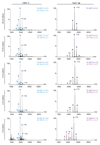Native Mass Spectrometry of Recombinant Proteins from Crude Cell Lysates
- PMID: 28345863
- PMCID: PMC5702260
- DOI: 10.1021/acs.analchem.7b00398
Native Mass Spectrometry of Recombinant Proteins from Crude Cell Lysates
Abstract
Determining the properties of proteins prior to purification saves time and labor. Here, we demonstrate a native mass spectrometry approach for rapid characterization of overexpressed proteins directly in crude cell lysates. The method provides immediate information on the identity, solubility, oligomeric state, overall structure, and stability, as well as ligand binding, without the need for purification.
Conflict of interest statement
The authors declare no competing financial interests.
Figures





Similar articles
-
Direct characterization of overproduced proteins by native mass spectrometry.Nat Protoc. 2020 Feb;15(2):236-265. doi: 10.1038/s41596-019-0233-8. Epub 2020 Jan 15. Nat Protoc. 2020. PMID: 31942081 Free PMC article.
-
Automated sample preparation method for mass spectrometry analysis on recombinant proteins.J Chromatogr A. 2009 May 15;1216(20):4457-64. doi: 10.1016/j.chroma.2009.03.041. Epub 2009 Mar 20. J Chromatogr A. 2009. PMID: 19345368
-
Characterization of Membrane Protein-Lipid Interactions by Mass Spectrometry Ion Mobility Mass Spectrometry.J Am Soc Mass Spectrom. 2017 Apr;28(4):579-586. doi: 10.1007/s13361-016-1555-1. Epub 2016 Dec 6. J Am Soc Mass Spectrom. 2017. PMID: 27924494
-
Expression, Solubilization, Refolding and Final Purification of Recombinant Proteins as Expressed in the form of "Classical Inclusion Bodies" in E. coli.Protein Pept Lett. 2021;28(2):122-130. doi: 10.2174/0929866527999200729182831. Protein Pept Lett. 2021. PMID: 32729411 Review.
-
Escherichia coli as a production host for novel enzymes from basidiomycota.Biotechnol Adv. 2014 Dec;32(8):1382-95. doi: 10.1016/j.biotechadv.2014.08.006. Epub 2014 Sep 2. Biotechnol Adv. 2014. PMID: 25193252 Review.
Cited by
-
High intracellular stability of the spidroin N-terminal domain in spite of abundant amyloidogenic segments revealed by in-cell hydrogen/deuterium exchange mass spectrometry.FEBS J. 2020 Jul;287(13):2823-2833. doi: 10.1111/febs.15169. Epub 2019 Dec 20. FEBS J. 2020. PMID: 31815338 Free PMC article.
-
Surface-Induced Dissociation: An Effective Method for Characterization of Protein Quaternary Structure.Anal Chem. 2019 Jan 2;91(1):190-209. doi: 10.1021/acs.analchem.8b05071. Epub 2018 Dec 18. Anal Chem. 2019. PMID: 30412666 Free PMC article. Review.
-
Approaches to Heterogeneity in Native Mass Spectrometry.Chem Rev. 2022 Apr 27;122(8):7909-7951. doi: 10.1021/acs.chemrev.1c00696. Epub 2021 Sep 1. Chem Rev. 2022. PMID: 34470219 Free PMC article. Review.
-
Native Mass Spectrometry: Recent Progress and Remaining Challenges.Annu Rev Biophys. 2022 May 9;51:157-179. doi: 10.1146/annurev-biophys-092721-085421. Epub 2022 Jan 4. Annu Rev Biophys. 2022. PMID: 34982572 Free PMC article. Review.
-
Smoothing membrane protein structure determination by initial upstream stage improvements.Appl Microbiol Biotechnol. 2019 Jul;103(14):5483-5500. doi: 10.1007/s00253-019-09873-1. Epub 2019 May 24. Appl Microbiol Biotechnol. 2019. PMID: 31127356 Free PMC article. Review.
References
-
- Structural Genomics C. China Structural Genomics C. Northeast Structural Genomics C. Graslund S, Nordlund P, Weigelt J, Hallberg BM, Bray J, Gileadi O, Knapp S, Oppermann U, et al. Nat Methods. 2008;5:135–146. - PubMed
-
- Sharon M. Science. 2013;340:1059–1060. - PubMed
-
- Liko I, Allison TM, Hopper JT, Robinson CV. Curr Opin Struct Biol. 2016;40:136–144. - PubMed
-
- Hernandez H, Robinson CV. Nat Protoc. 2007;2:715–726. - PubMed
Publication types
MeSH terms
Substances
Grants and funding
LinkOut - more resources
Full Text Sources
Other Literature Sources

